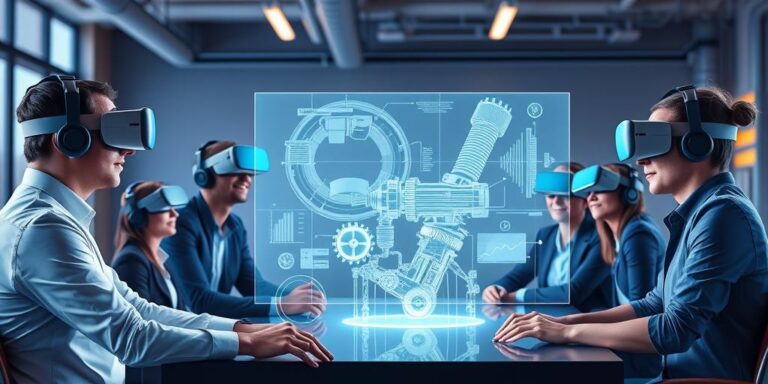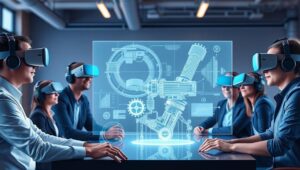Enterprise Adoption of AR/VR for Training and Collaboration (2025+)
The integration of augmented reality (AR) and virtual reality (VR) technologies into enterprise training and collaboration is poised for significant growth beyond 2025. This article examines the drivers, applications, challenges, and future trends shaping the adoption of AR/VR in the corporate world.
Drivers of AR/VR Adoption
Several factors are propelling the adoption of AR/VR within enterprises:
- Enhanced Training Capabilities: AR/VR offers immersive, hands-on training experiences that improve knowledge retention and skill development compared to traditional methods.
- Improved Collaboration: Remote teams can collaborate in shared virtual environments, enhancing communication and productivity.
- Cost Reduction: While initial investment may be significant, AR/VR can reduce costs associated with travel, physical training materials, and on-site supervision.
- Increased Safety: AR/VR simulations allow employees to train for hazardous situations in a safe, controlled environment.
- Technological Advancements: Ongoing improvements in hardware and software are making AR/VR more accessible, affordable, and user-friendly.
Key Applications
AR/VR is finding applications across various enterprise functions:
- Employee Onboarding: New hires can experience company culture, processes, and job roles through immersive VR tours.
- Technical Training: Technicians and engineers can practice complex tasks and equipment maintenance in realistic AR/VR simulations.
- Sales and Marketing: AR/VR can create engaging product demonstrations and virtual showrooms for potential customers.
- Remote Collaboration: Distributed teams can collaborate on projects in shared virtual workspaces, using AR tools to overlay digital information onto real-world environments.
- Product Design and Development: Designers and engineers can visualize and interact with 3D models in AR/VR, accelerating the design process and reducing errors.
Challenges to Adoption
Despite the potential benefits, several challenges hinder widespread AR/VR adoption:
- High Initial Costs: The cost of AR/VR hardware, software, and content development can be a barrier for some enterprises.
- Technical Complexity: Integrating AR/VR into existing IT infrastructure and workflows requires specialized expertise.
- User Experience: Poor user experience, including motion sickness and cumbersome interfaces, can limit adoption.
- Security Concerns: Protecting sensitive data in virtual environments is a critical concern.
- Lack of Standardization: The absence of industry standards for AR/VR hardware and software creates interoperability challenges.
Future Trends
The future of AR/VR in the enterprise is characterized by several emerging trends:
- 5G Connectivity: Faster and more reliable 5G networks will enable seamless AR/VR experiences, particularly for mobile and remote applications.
- Cloud-Based AR/VR: Cloud platforms will provide scalable and cost-effective solutions for delivering AR/VR content and applications.
- AI Integration: Artificial intelligence (AI) will enhance AR/VR experiences through personalized training, intelligent assistance, and adaptive simulations.
- Extended Reality (XR): The convergence of AR, VR, and mixed reality (MR) technologies will create more versatile and immersive enterprise solutions.
- Focus on User Experience: Investments in ergonomic hardware, intuitive interfaces, and engaging content will drive greater user adoption.
Conclusion
AR/VR technologies hold immense potential for transforming enterprise training and collaboration. While challenges remain, ongoing advancements and increasing adoption rates suggest a promising future. As AR/VR becomes more accessible, affordable, and user-friendly, enterprises that embrace these technologies will gain a competitive edge in the years to come.




